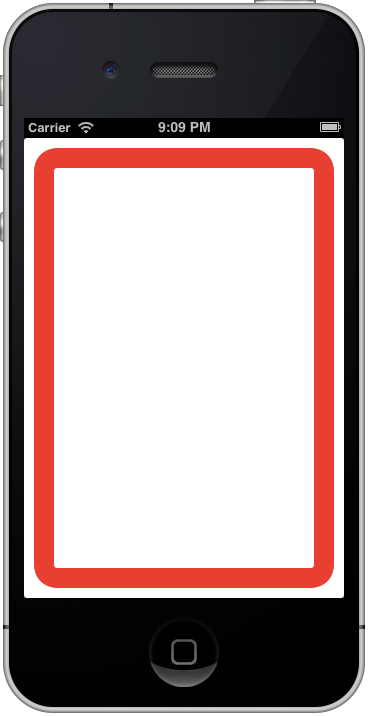Comment dessiner un rectangle arrondi dans Core Graphics / Quartz 2D?
je dois dessiner un contour pour un rectangle arrondi. Je sais que je peux faire des lignes et des arcs, mais peut-être qu'il y a aussi une fonction pour les rects arrondis?
8 réponses
au lieu de faire votre propre chemin hors des lignes et des arcs, vous pouvez utiliser
[UIBezierPath bezierPathWithRoundedRect:cornerRadius:]
ou
[UIBezierPath bezierPathWithRoundedRect:byRoundingCorners:cornerRadii:]
(le second permet de spécifier les coins arrondis)
disponible en iOS 3.2 ou plus tard.
il n'y a pas de moyen préemballé pour cela, vous devez combiner les arcs pour le faire, le projet apples quartzdemo montre le code pour le faire, voici une référence Démo Quartz et voici le code qu'ils fournissent
// As a bonus, we'll combine arcs to create a round rectangle!
// Drawing with a white stroke color
CGContextRef context=UIGraphicsGetCurrentContext()
CGContextSetRGBStrokeColor(context, 1.0, 1.0, 1.0, 1.0);
// If you were making this as a routine, you would probably accept a rectangle
// that defines its bounds, and a radius reflecting the "rounded-ness" of the rectangle.
CGRect rrect = CGRectMake(210.0, 90.0, 60.0, 60.0);
CGFloat radius = 10.0;
// NOTE: At this point you may want to verify that your radius is no more than half
// the width and height of your rectangle, as this technique degenerates for those cases.
// In order to draw a rounded rectangle, we will take advantage of the fact that
// CGContextAddArcToPoint will draw straight lines past the start and end of the arc
// in order to create the path from the current position and the destination position.
// In order to create the 4 arcs correctly, we need to know the min, mid and max positions
// on the x and y lengths of the given rectangle.
CGFloat minx = CGRectGetMinX(rrect), midx = CGRectGetMidX(rrect), maxx = CGRectGetMaxX(rrect);
CGFloat miny = CGRectGetMinY(rrect), midy = CGRectGetMidY(rrect), maxy = CGRectGetMaxY(rrect);
// Next, we will go around the rectangle in the order given by the figure below.
// minx midx maxx
// miny 2 3 4
// midy 1 9 5
// maxy 8 7 6
// Which gives us a coincident start and end point, which is incidental to this technique, but still doesn't
// form a closed path, so we still need to close the path to connect the ends correctly.
// Thus we start by moving to point 1, then adding arcs through each pair of points that follows.
// You could use a similar tecgnique to create any shape with rounded corners.
// Start at 1
CGContextMoveToPoint(context, minx, midy);
// Add an arc through 2 to 3
CGContextAddArcToPoint(context, minx, miny, midx, miny, radius);
// Add an arc through 4 to 5
CGContextAddArcToPoint(context, maxx, miny, maxx, midy, radius);
// Add an arc through 6 to 7
CGContextAddArcToPoint(context, maxx, maxy, midx, maxy, radius);
// Add an arc through 8 to 9
CGContextAddArcToPoint(context, minx, maxy, minx, midy, radius);
// Close the path
CGContextClosePath(context);
// Fill & stroke the path
CGContextDrawPath(context, kCGPathFillStroke);
UIBezierPath *bezierPath = [UIBezierPath bezierPathWithRoundedRect:bubbleBounds cornerRadius:15.0];
CGContextSetStrokeColorWithColor(context, [UIColor grayColor].CGColor);
[bezierPath stroke];
Voici une fonction que j'ai écrite qui arrondit l'entrée rect en utilisant un rayon de coin.
CGMutablePathRef createRoundedCornerPath(CGRect rect, CGFloat cornerRadius) {
// create a mutable path
CGMutablePathRef path = CGPathCreateMutable();
// get the 4 corners of the rect
CGPoint topLeft = CGPointMake(rect.origin.x, rect.origin.y);
CGPoint topRight = CGPointMake(rect.origin.x + rect.size.width, rect.origin.y);
CGPoint bottomRight = CGPointMake(rect.origin.x + rect.size.width, rect.origin.y + rect.size.height);
CGPoint bottomLeft = CGPointMake(rect.origin.x, rect.origin.y + rect.size.height);
// move to top left
CGPathMoveToPoint(path, NULL, topLeft.x + cornerRadius, topLeft.y);
// add top line
CGPathAddLineToPoint(path, NULL, topRight.x - cornerRadius, topRight.y);
// add top right curve
CGPathAddQuadCurveToPoint(path, NULL, topRight.x, topRight.y, topRight.x, topRight.y + cornerRadius);
// add right line
CGPathAddLineToPoint(path, NULL, bottomRight.x, bottomRight.y - cornerRadius);
// add bottom right curve
CGPathAddQuadCurveToPoint(path, NULL, bottomRight.x, bottomRight.y, bottomRight.x - cornerRadius, bottomRight.y);
// add bottom line
CGPathAddLineToPoint(path, NULL, bottomLeft.x + cornerRadius, bottomLeft.y);
// add bottom left curve
CGPathAddQuadCurveToPoint(path, NULL, bottomLeft.x, bottomLeft.y, bottomLeft.x, bottomLeft.y - cornerRadius);
// add left line
CGPathAddLineToPoint(path, NULL, topLeft.x, topLeft.y + cornerRadius);
// add top left curve
CGPathAddQuadCurveToPoint(path, NULL, topLeft.x, topLeft.y, topLeft.x + cornerRadius, topLeft.y);
// return the path
return path;
}
comment utiliser la fonction, en supposant que vous sous-classe UIView et outrepassez drawRect:
- (void)drawRect:(CGRect)rect {
// constants
const CGFloat outlineStrokeWidth = 20.0f;
const CGFloat outlineCornerRadius = 15.0f;
const CGColorRef whiteColor = [[UIColor whiteColor] CGColor];
const CGColorRef redColor = [[UIColor redColor] CGColor];
// get the context
CGContextRef context = UIGraphicsGetCurrentContext();
// set the background color to white
CGContextSetFillColorWithColor(context, whiteColor);
CGContextFillRect(context, rect);
// inset the rect because half of the stroke applied to this path will be on the outside
CGRect insetRect = CGRectInset(rect, outlineStrokeWidth/2.0f, outlineStrokeWidth/2.0f);
// get our rounded rect as a path
CGMutablePathRef path = createRoundedCornerPath(insetRect, outlineCornerRadius);
// add the path to the context
CGContextAddPath(context, path);
// set the stroke params
CGContextSetStrokeColorWithColor(context, redColor);
CGContextSetLineWidth(context, outlineStrokeWidth);
// draw the path
CGContextDrawPath(context, kCGPathStroke);
// release the path
CGPathRelease(path);
}
exemple de sortie:

si vous voulez avoir des coins arrondis sur N'importe quel uivi (ou sous-classe) la manière facile est de mettre la propriété cornerRadius sur la couche de la vue. Voir prévisualiser l'image arrondie dans l'iphone
CGPathCreateWithRoundedRect() faire ce que vous souhaitez.
CGPathRef CGPathCreateWithRoundedRect(
CGRect rect,
CGFloat cornerWidth,
CGFloat cornerHeight,
const CGAffineTransform *transform
);
disponible à partir de iOS 7.0
Swift:
let rect: CGRect = ...
let path = UIBezierPath(roundedRect: rect, cornerRadius: 5.0)
CGContextAddPath(context, path.CGPath)
CGContextSetStrokeColorWithColor(context, UIColor.clearColor().CGColor)
CGContextDrawPath(context, CGPathDrawingMode.FillStroke)
peut-être... trois? des années de retard, mais ces jours-ci j'utilise ça sans problème.
@import CoreGraphics;
@interface YourViewController ()
@property (weak, nonatomic) IBOutlet UIButton *theButton;
@end
- (void)viewDidLoad
{
[super viewDidLoad];
self.theButton.layer.cornerRadius = 5.0f;
self.theButton.layer.masksToBounds = YES;
// Another useful ones
// Scaling the view (width, height)
self.theButton.transform = CGAfflineTransformMakeScale(1.50f, 1.50f);
// Setting an alpha value (transparency) - nice with Activity Indicator subviews
self.theButton.alpha = 0.8f;
}